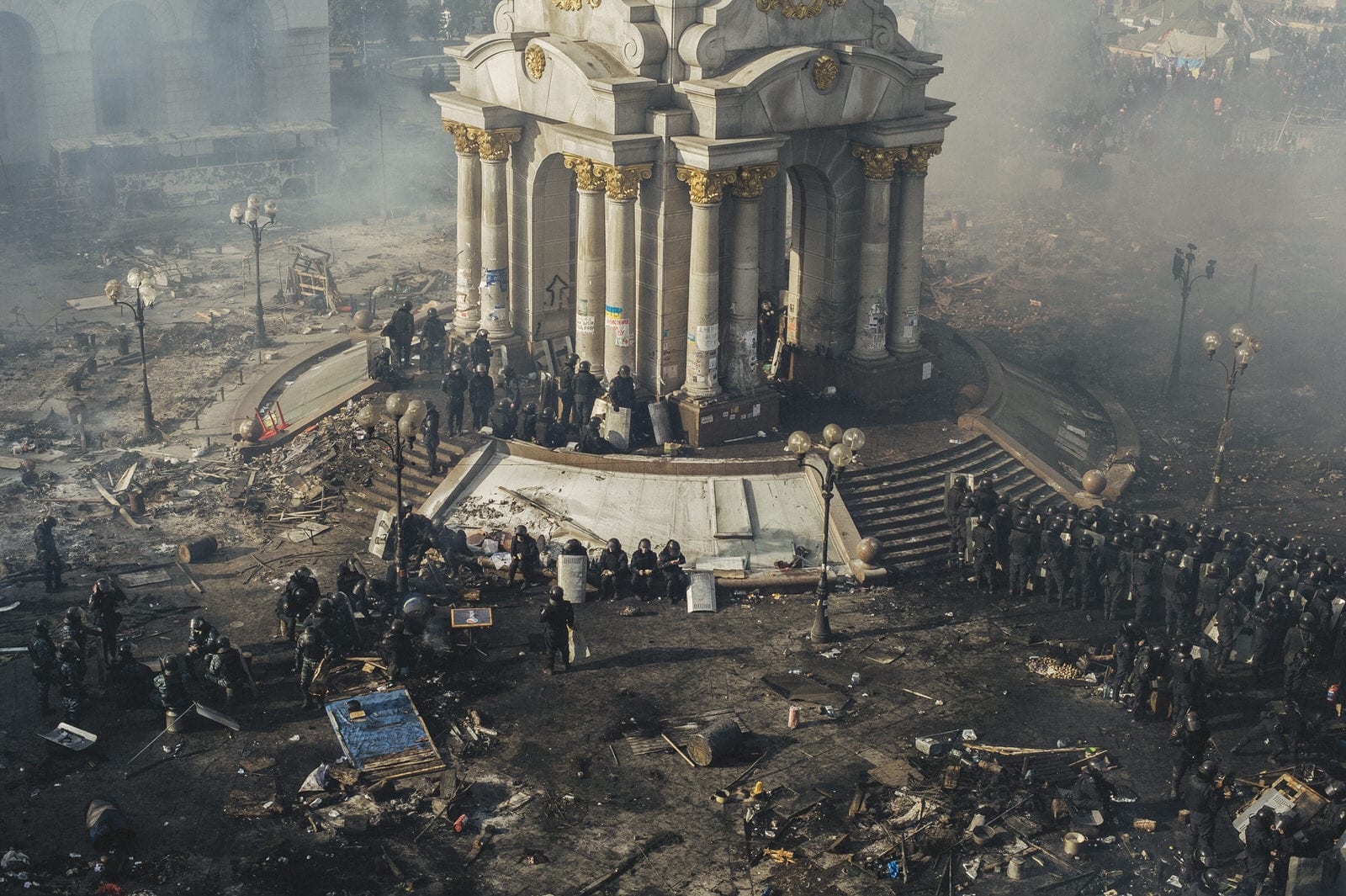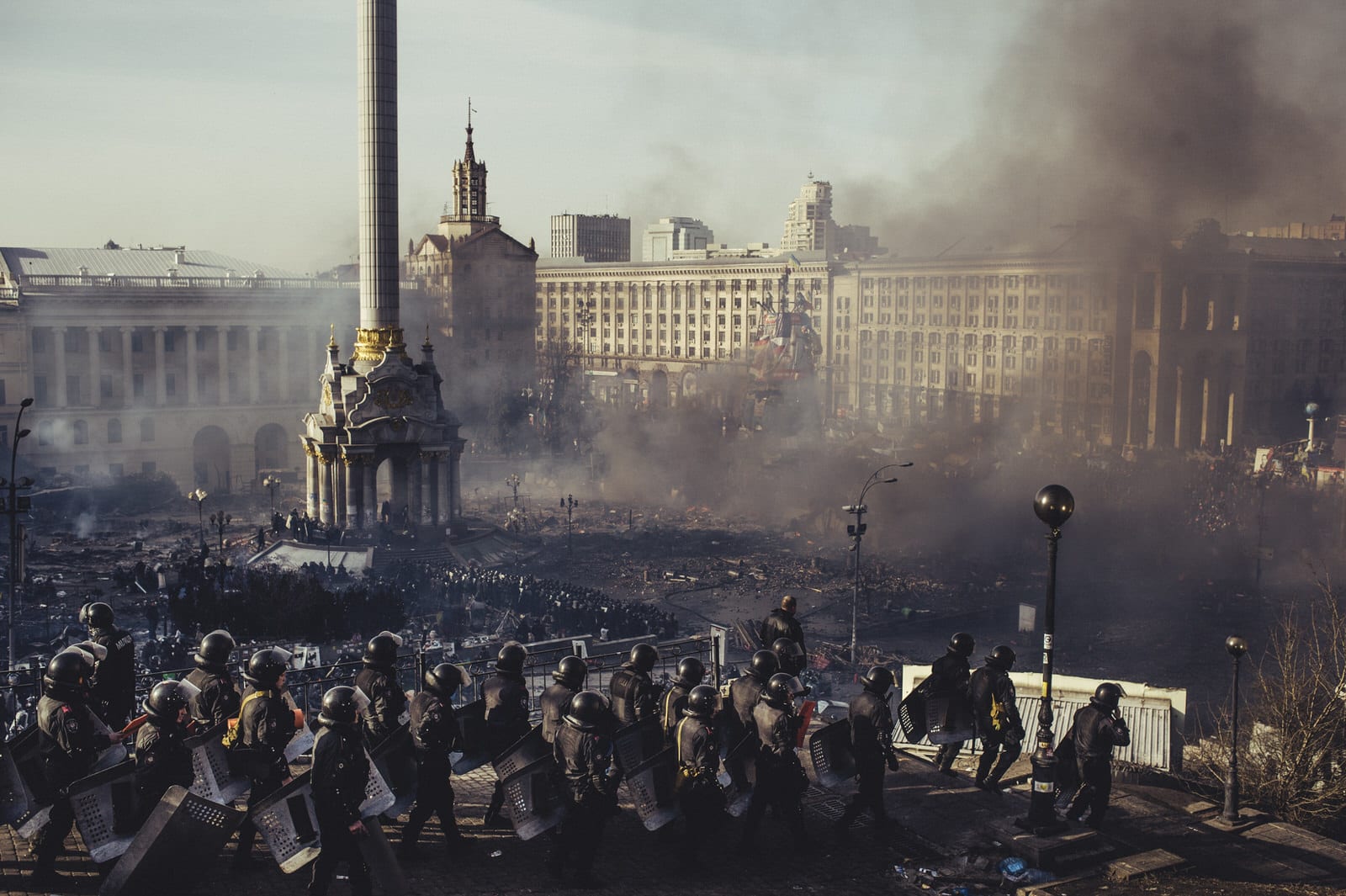As winter approached in late 2013, the rumblings of political, social and civil discontent in Ukraine was growing louder by the day. When Viktor Yanukovych, the nation’s president, rejected a deal with the European Union for a $15bn aid package from Russia, many citizens were furious. Promising greater political integration and closer cultural ties, lots of Ukrainians saw the EU deal as a new path for the country, whose economic predicament was worsening.
On the 21st November, up to 20,000 protesters gathered in Kiev’s Maidan Nezalezhnosti (Independence Square) after spreading messages on social media. By the 24th, their numbers had swelled – somewhere between 50,000 and 200,000, depending on who you asked. As pro-EU demonstrators chanted and marched, a small group attempted to storm the Government Building.
That’s when the trouble really began.
The wave of civil unrest flooded the streets, fuelled by a heady mix of Cold War-era hostilities, far-right opportunism and pan-European democratic idealism. What became known as Euromaidan led to the Ukrainian Revolution, with President Yanukovych being ousted from power in February 2014.
Ukrainian photojournalist Maxim Donyduk documented this iconic moment in his nation’s history in his project Culture of the Confrontation – a Series runner-up in the 2016 International Photography Awards – depicting the bloody battles of Euromaidan in 2013.
“FOR ME, EMOTIONS ARE MORE IMPORTANT THAN FACTS.”
His extraordinary images, which were also shortlisted for the sixth edition of the Prix Prictet, speak to the kind of bravery all photojournalists need to document scenes of conflict, but their weathered beauty takes them to an epic scale where lines blur; legend and reality, past and present.



For Dondyuk, inserting himself into the drama and tumult that was unfolding was less a choice, and more a moral obligation. “I am a documentary photographer – I have faced dangerous situations before and I will again, so I absolutely didn’t think about the dangers of going to Maidan. I began to shoot because this was happening in my country, in the city where I live. At some point I realised that it touches me personally, that this is a historic moment in my country.”
“I SAW NOT THE UKRAINIAN REVOLUTION – I SAW BATTLES FROM PREVIOUS WARS, LEGENDS AND FAIRY TALES.”
In Dondyuk’s Euromaidan, we see voluminous shafts of light emerge between gigantic plumes of blackened smoke, the rising fires breaking out on the steps of centuries-old buildings and tattered Ukrainian flags marked with the dirt and blood of those flying it proudly. Dondyuk has previously called Euromaidan “one of the most beautiful revolutions, like a scene from a Hollywood film”.
The aesthetic qualities of the images do raise an uneasy question – is it misleading, even dangerous, to make these scenes of violence look appealing?
“Photography is my visual language, because sometimes it is difficult to find the words to convey what I see.
“From the very beginning Euromaidan turned into a real performance, a battle of opposites. Good and evil, light and shadow, thick black smoke and whiteness of the February snow, orange helmets against black. I kept being reminded of Realist paintings, who long before photography, documented historical events in the same manner. When you look at their works in a museum, you don’t question [their process].



“It wasn’t so important for me to answer the ‘what, where, why?’ of the situation. I wanted to evoke peoples’ associations and memories and get them to see what I saw. I saw not the Ukrainian revolution at Independence Square, I saw battles from previous wars, legends and fairy tales.”
The title of the series is a clear nod to the clash of two distinct groups in Ukrainian society – an older culture nostalgic about the Soviet Union and a younger generation attempting to build a new future. But as Dondyuk makes clear, the ideas within the project and the title sprawl wider than the confines of nationalism:
“At Maidan it was not two different generations – it were two cultural layers who live on one territory. This confrontation is eternal, it started long ago and will continue again and again. The country it happens in doesn’t even matter. For me, in photography emotions are more important than facts.”


A list compiled by Ukrainian media watchdog Telekrytyka in December 2013 listed over 40 injured journalists and photographers, with many reporting deliberate beatings by riot police despite holding journalist credentials – including a photographer from the New York Times.
“EVERY WEEK, SOMEONE I PHOTOGRAPHED WOULD DIE.”
Impassioned protestors, hard-right disruptors and Western photojournalists were being treated with equal disdain. One particular moment is particularly vivid in Dondyuk’s memory, as he recounts:
“The first and last time I really felt fear was when snipers opened fire on protesters on the Independence Square. When all the protesters ran towards the attack, I ran with them, staying with a small group of protesters near the stairs of the October Palace.
“From the building emerged men in black holding guns and opened fire in our direction. We were running away from the fire, hiding from the shots behind the trees. I saw bodies of dead protesters for the first time, and countless wounded being carried to the Hotel Ukraine, which was used as a [makeshift] field hospital.
“At that moment, I felt fear.”


That kind of exhilarating proximity to the situation is partly what drives photojournalists. Dondyuk’s first experience of this “immersion” was on a project he shot in 2010 and 2011, shooting the TB epidemic in Donbass:
“It was my first serious project, and it became very difficult psychologically. I became acquainted with people and over time I followed them to their grave. I was living in close, constant contact with death; every week someone I photographed would die. These projects change me personally – I don’t know how I could get this experience without photography.”
Find more of Maxim’s work here.
Maxim is crowdfunding via Kickstarter to turn the series into a photobook with Kehrer Verlag – find out more and contribute to the campaign here.
This marked the 10th edition of the British Journal of Photography’s International Photography Awards, one of the world’s leading showcases for contemporary photographic talent. The shortlisted photographers will have their worked featured online by British Journal of Photography, and receive WeTransfer Plus accounts, allowing for 20GB of transfers, personalised wallpapers and URLs and long-term storage.
